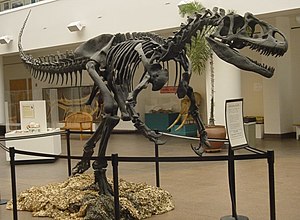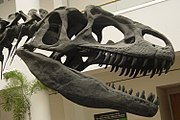Allosaurus
| Allosaurus | ||||||||||||
|---|---|---|---|---|---|---|---|---|---|---|---|---|

Skeleton reconstruction of Allosaurus fragilis |
||||||||||||
| Temporal occurrence | ||||||||||||
| Upper Jurassic ( Kimmeridgian to Tithonian ) | ||||||||||||
| 157.3 to 145 million years | ||||||||||||
| Locations | ||||||||||||
| Systematics | ||||||||||||
|
||||||||||||
| Scientific name | ||||||||||||
| Allosaurus | ||||||||||||
| Marsh , 1877 | ||||||||||||
| species | ||||||||||||
Allosaurus ( Greek for different lizard ) is a genus of theropod dinosaurs . She lived in the era of the Upper Jurassic and isproven by findsin North America and southern Europe . Earlier finds of the genus from the Upper Jurassic of Tanzania and the Lower Cretaceous of Australia cannot be assigned with certainty.
Othniel Charles Marsh , in his first description from 1877, gave the genus its name after the anatomy of the vertebral bones, which were designed differently from the previously known dinosaur vertebrae.
The Allosaurus was one of the largest carnivorous dinosaurs of its time and was up to twelve meters long and several tons heavy.
Anatomy and differences between species
The narrow head of this dinosaur adorned two large humps above the eyes. The skull , which is quite large overall, has, as is usual with theropods, large openings, some of which were created through air-filled cavities (e.g. through expansion of the paranasal sinuses ). Thus it does not consist of a massive bone and was therefore much lighter.
The neck was very strong and extremely flexible. The animal only moved on its hind legs. The relatively short arms were also very strong and ended in a three-fingered hand with sharp claws. The hind legs were long, the Allosaurus was a toe walker like all theropods. A long tail balanced the body on its hind legs.
The fragile and European arteries do not differ greatly.
Way of life
The theses about the Allosaurus way of life diverge. A few paleontologists see Allosaurus fragilis as a successful scavenger , others as a skilled hunter who could also kill large sauropods in groups . The light construction with strong hind legs speaks more for a hunter. This is also supported by examinations of the skull, according to which it is designed for very high loads. Such stresses do not occur when simply chewing a carcass, but they do occur when hunting a living animal. There are indications of possibly sociable hunting behavior in groups, on the one hand, from finds of several animals in one site (e.g. in the Cleveland-Lloyd Quarry) and from finds of footprints of several large theropods that apparently walked together. However, both are not reliable evidence of group behavior, as the skeletal assemblies can also be explained differently and the traces cannot be reliably assigned to Allosaurus .
Reproduction and development
According to a group of US researchers, some particularly large dinosaurs, such as the Allosaurus, were able to reproduce as early as ten years of age. This behavior is an evolutionary advantage compared to those species that only reproduce in adulthood. This knowledge could be proven by means of the bone finds. Even in young specimens, the bones had a tissue structure that was distinctive for their reproductive capacity, which is necessary for the calcium reserves that are constantly and quickly available for the production of the egg shells. The same structure is known in descendants living today, for example birds.
Most known large Allosaurus specimens are estimated to be between 13-19 years old. This estimate is based on examinations of the cubits , femurs , shins and humerus of each specimen. The maximum age of the species was probably 22-28 years, which is comparable to that of other large theropods. Growth was most likely most rapid at the age of 15. It is believed that Allosaurus gained 148 kg per year during this period.
habitat
Allosaurus lived at the same time as Stegosaurus , Brachiosaurus and Diplodocus in the Morrison Formation in North America. The Morrison Formation represents a rather open and dry habitat with large rivers, flood plains and small lakes. The large theropods Torvosaurus , Ceratosaurus and Marshosaurus , which also occur in this formation, are potential food competitors of Allosaurus . At least there is multiple evidence of temporal and spatial coexistence in the deposit area of the Morrison Formation for these taxa. Smaller theropods of the Morrison formation, such as Ornitholestes or Coelurus , on the other hand, competed at most with young animals and were more on the menu in adult allosaurs.
size
Allosaurus fragilis was on average 11-12 meters long, 3-5 meters high and about 1.5 tons in weight. However, there are also some fragmentary finds that suggest that individual animals could grow significantly larger. There are also remains of a very large allosaurid called Allosaurus maximus or Saurophaganax maximus with an estimated length of up to over 13 meters. Two of the best known specimens of Allosaurus are Big Al and Big-Al 2 that have been found by paleontologists in the US and in the BBC documentary The Ballad of Big Al ( The Ballad of Big Al were shown).
In popular culture
Allosaurs appear in the films The Lost World , The Curse of Monte Bravo , Gwangi's Revenge and Planet of the Monsters, and Jurassic World: The Fallen Kingdom .
Furthermore was Allosaurus in the multi-part television series In the Realm of the Giants ( Walking with Dinosaurs to see 1999), the special The Ballad of Big Al ( The Ballad of Big Al , 2000), based on bones found and their evaluation, tells the story of a growing allosaur.
literature
- Gregory S. Paul : Genus Allosaurus. In: Gregory S. Paul: Predatory Dinosaurs of the World. A complete illustrated guide. Simon & Schuster, New York NY et al. 1988, ISBN 0-671-61946-2 , pp. 307-313.
Web links
Individual evidence
- ^ Gregory S. Paul: The Princeton Field Guide To Dinosaurs. Princeton University Press, Princeton NJ et al. 2010, ISBN 978-0-691-13720-9 , pp. 94-96, online .
- ↑ Ben Creisler: Dinosauria Translation and Pronunciation Guide A. Archived from the original on November 6, 2011 ; accessed on August 2, 2014 .
- ↑ Andrew H. Lee, Sarah Werning: Sexual maturity in growing dinosaurs does not fit reptilian growth models. In: Proceedings of the National Academy of Sciences of the United States of America . Vol. 105, No. 2, 2008, pp. 582-587, doi: 10.1073 / pnas.0708903105 .
- ↑ Dinosaurs: early maturity T. rex. on: sueddeutsche.de , January 15, 2008.
- ↑ Paul J. Bybee, Andrew H. Lee, Ellen-Thérèse Lamm: Sizing the Jurassic theropod dinosaur Allosaurus: Assessing growth strategy and evolution of ontogenetic scaling of limbs. In: Journal of Morphology. Vol. 267, No. 3, 2006, ISSN 0362-2525 , pp. 347-359, doi: 10.1002 / jmor.10406 .
- ↑ JR Foster: Paleoecological Analysis of the Vertebrate Fauna of the Morrison Formation (Upper Jurassic), Rocky Mountain Region, USA In: New Mexico Museum of Natural History and Science , Bulletin 23, 2003, 95 pp. ( Full text )
- ↑ Thomas R. Holtz Jr .: Dinosaurs. The most complete, up-to-date Encyclopedia for Dinosaur Lovers of all Ages. Random House, New York NY 2007, ISBN 978-0-375-82419-7 , p. 104.
- ↑ Thomas R. Holtz Jr .: Dinosaurs. The most complete, up-to-date Encyclopedia for Dinosaur Lovers of all Ages. Random House, New York NY 2007, ISBN 978-0-375-82419-7 , p. 100.





